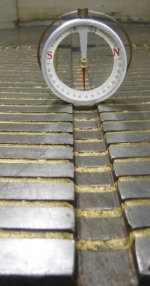9100
Diamond
- Joined
- Nov 1, 2004
- Location
- Webster Groves, MO
This is a Blanchard grinder with a 60" rotary table. It was overhauled a few years ago but has never held work like it should. The surface has 25 segments but only 5 coils. I checked the polarities of the magnet segments with a magnetic compass and found that the two outer ones read N, then the next 7 were S. This pattern repeated across the table. The S poles were over the coils and the N poles were above the spacers between them. In other words, all the coils are connected in the same polarity and the return poles are the narrow segments between them. It seems to me that the coils should be connected alternately. Lifting the table out and changing the connections would be a major operation, so I want to be absolutely certain before I tell the customer to do that.
If anyone has a similar grinder, just holding a magnetic compass turned vertical over the table with a little bit of current on and moving it from the center to the OD while watching the needle should answer the question.
Bill
If anyone has a similar grinder, just holding a magnetic compass turned vertical over the table with a little bit of current on and moving it from the center to the OD while watching the needle should answer the question.
Bill







